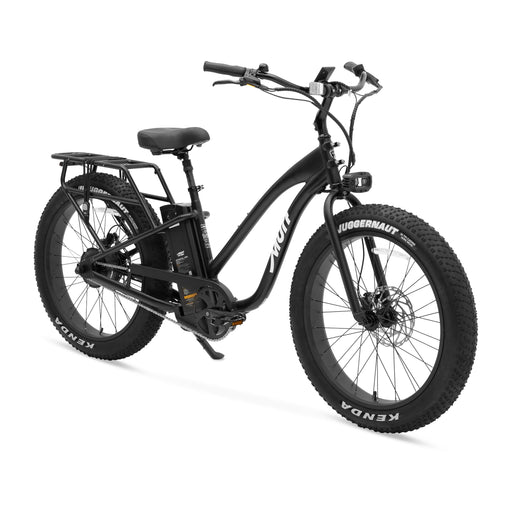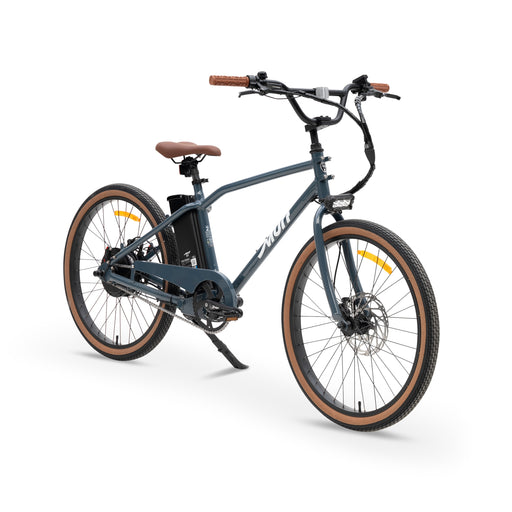Why Do Volts Matter: 52volts vs 48 volts vs 36 volts
Why Volts Matter: 52 Volts vs. 48 Volts vs. 36 Volts
Riding an electric bike has a number of benefits that can make it an ideal choice for many cyclists. Increasing your efficiency and range can make it possible to ride for many more miles than you ever could on your own power. Lithium-ion batteries are lightweight, charge quickly, and tend to last a fairly long time. Understanding how batteries can help you choose the best e-bike for your needs.
Definitions
- Volt: A volt is a measurement of electric potential. A volt is also known as the electromotive force and is symbolized with a "V."
- Watts: A watt is a measurement of power. A watt represents the rate at which work is done when one ampere of current flows through an electrical potential difference of one volt.
- Horsepower: Horsepower is a unit of power that is equal to 550 foot-pounds per second or 745.7 watts.
- Battery: A battery is a device that contains at least one electrochemical cell and has external connections to power electrical devices.
- Watt Hours: A watt hour is a unit of energy used to measure the amount of work performed or generated.
- Lithium: Lithium is a lightweight element contained in batteries.
- Amp: An amp is also known as an ampere, and it's a unit of electrical current.
- Amp Hours: Amp hours are the rating used to show how much amperage a battery can provide for one hour.
- Ohm: An ohm is a unit of an electrical circuit's resistance.
Electric Bike Battery Basics
Electric bikes, or e-bikes, are special bicycles that come equipped with a battery-powered assist mode that provides electric power when the rider wants it. A small motor will provide pedaling assistance to help with extra power to climb hills. Some bikes also have a throttle that engages the motor at the press of a button. E-bike batteries will provide power for up to 70 miles on a single charge. Regular charging will be necessary, and with ongoing use, riders will also need to replace the battery when it wears out.
Volts vs. Watts
Watts can't exist without volts: Watts are the product of volts and amps. Volts are comparable to pressure, and watts are comparable to rate. Both voltage and amperage are important, but wattage combines these two to show an indicator that is comparable to the speed of power output.
- What's the Difference Between Amps, Volts, and Watts?
- What's the Difference Between Watts and Volt-Amperes?
Volts vs. Horsepower
Horsepower measures power, or the relationship between speed and torque. Voltage measures energy carried in a circuit. Voltage is comparable to force. It's possible to measure current in a motor as both horsepower and voltage.
The Difference Between 48V and 52V Batteries
Electric bikes typically come with a 48-volt or 52-volt battery. The difference between the two is power and performance: A 52V battery delivers better performance. A higher-voltage battery provides greater efficiency, with the battery using less electricity to provide the same or better power for the bike. Battery life tends to be longer for a 52V battery, too. Meanwhile, the formerly popular 36V battery option has fallen out of favor because it doesn't perform as well as either 48V or 52V batteries.
Which Is Better: 48V or 52V?
The biggest difference in battery voltages appears when either battery is about half discharged. At that point, for a 48V battery, a significant power drop occurs. A 52V battery will not experience the same drop in power at the halfway point, making it a better choice. Most newer e-bikes are designed to work with 52V batteries.
- How Big Should You Make Your Battery?
- Electric Bike Battery Basics: What Are These Volts and Amp Hours?
Keeping a Strong Battery
Purchase the best-quality battery you can afford. Use your bike often, and recharge the battery often. If you don't plan to use the bike for more than a week, charge the battery to between 40 and 70 percent before you store it. Store the battery in a cool and dry place, and monitor the battery's charge during storage to keep it in the recommended range.
How to Keep a Single Charge Strong
Extending the range of an e-bike battery can help to keep you going through a long ride. Use a lower gear when climbing hills; this will decrease torque and extend battery life. It's also important to recharge the battery after every ride, giving the charge at least three hours so the battery is fully topped off. Maintain the tires and tire pressure to extend battery life, too.
- The Five Best Tips to Get the Most Out of Your E-Bike Battery
- How Long Does the Battery of an Electric Bike Last?
Resources
- Electric Bike FAQs
- Serial and Parallel Battery Configurations and Information
- Electric Scooter, E-Bike, and Rideable Tech Options
- Know Your E-Bike Batteries Inside and Out
- Should I Buy an Electric Bicycle?
- Now Is the Perfect Time for an E-Bike
- Buying the Best E-Bike
- How to Choose an Electric Bike
- Seven Things You Should Know Before You Buy Your First E-Bike





 info@murfelectricbikes.com
info@murfelectricbikes.com
 1-949-218-5920 (SC)
1-949-218-5920 (SC)
 Find Retail or Service
Find Retail or Service















